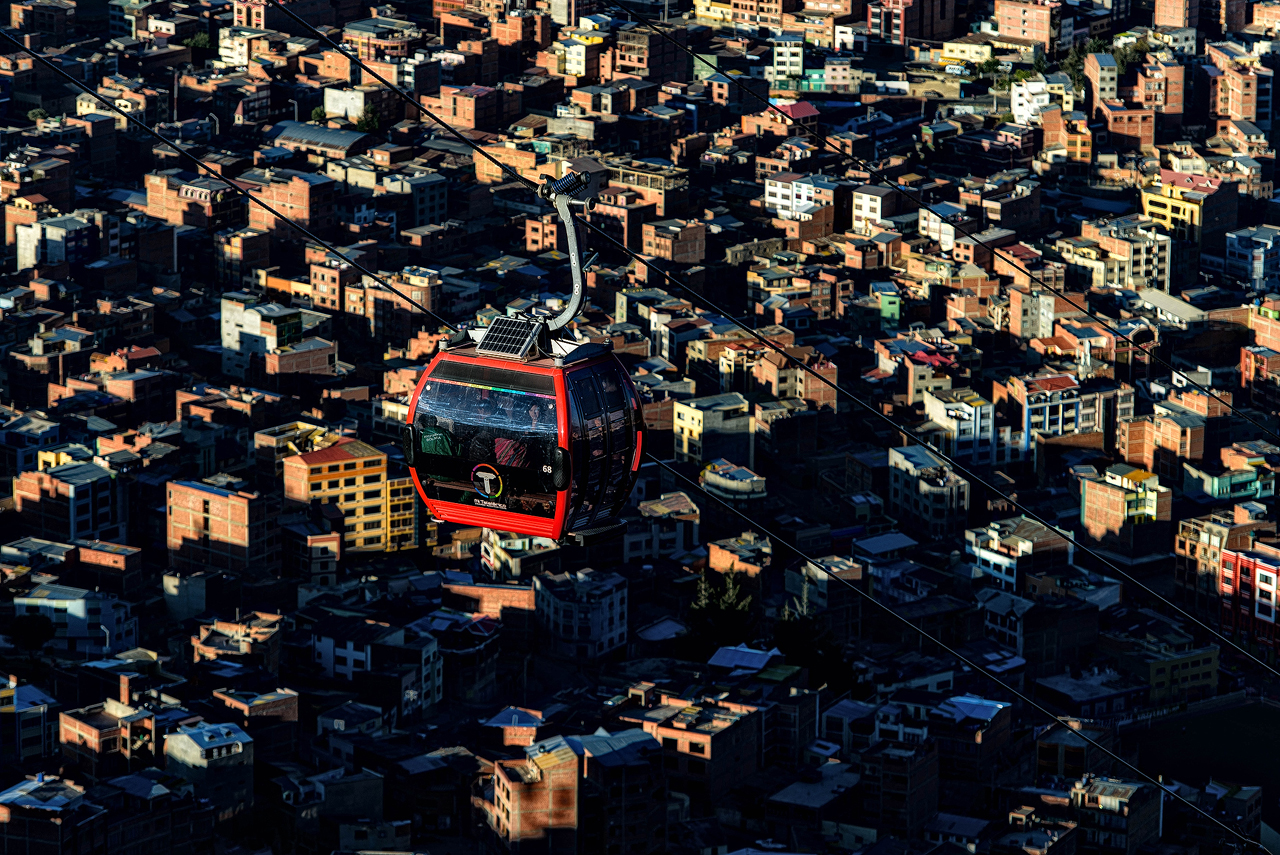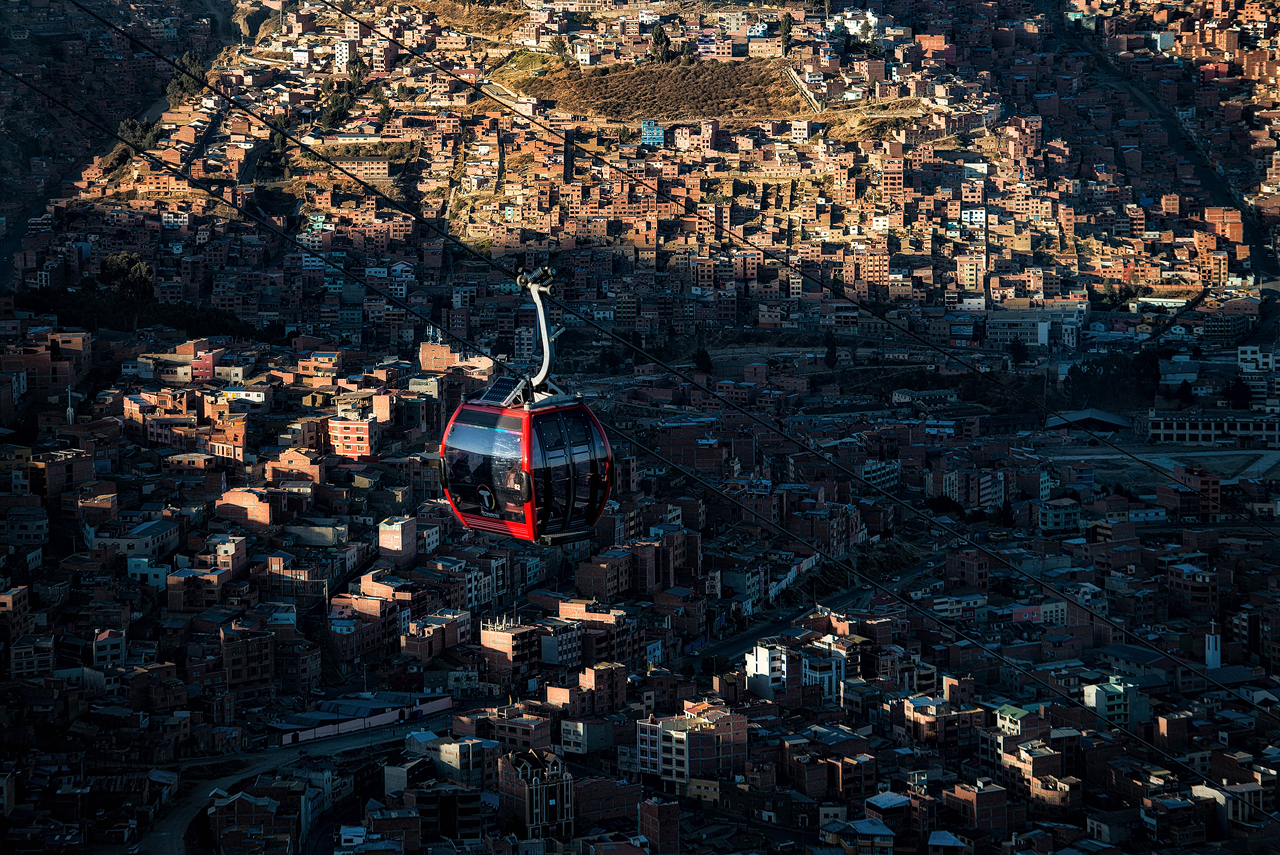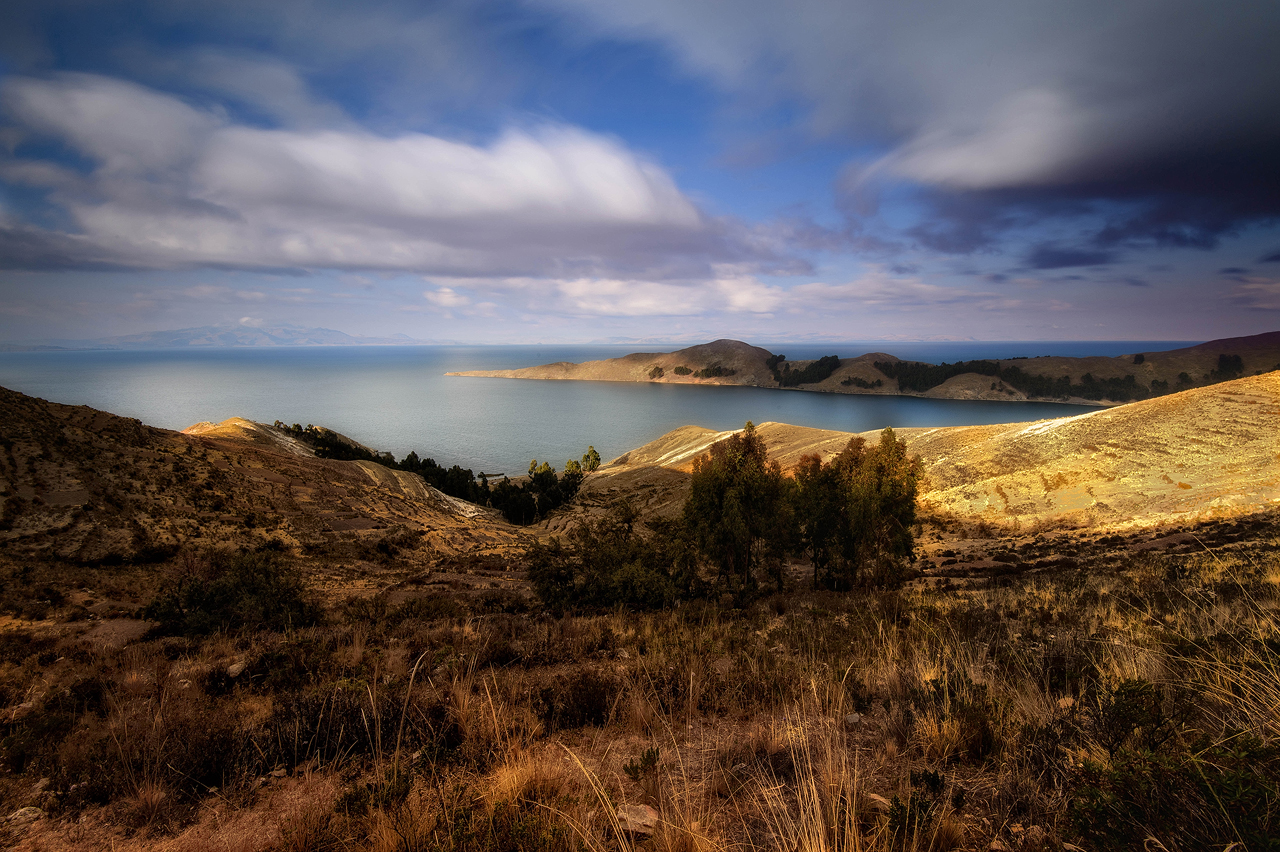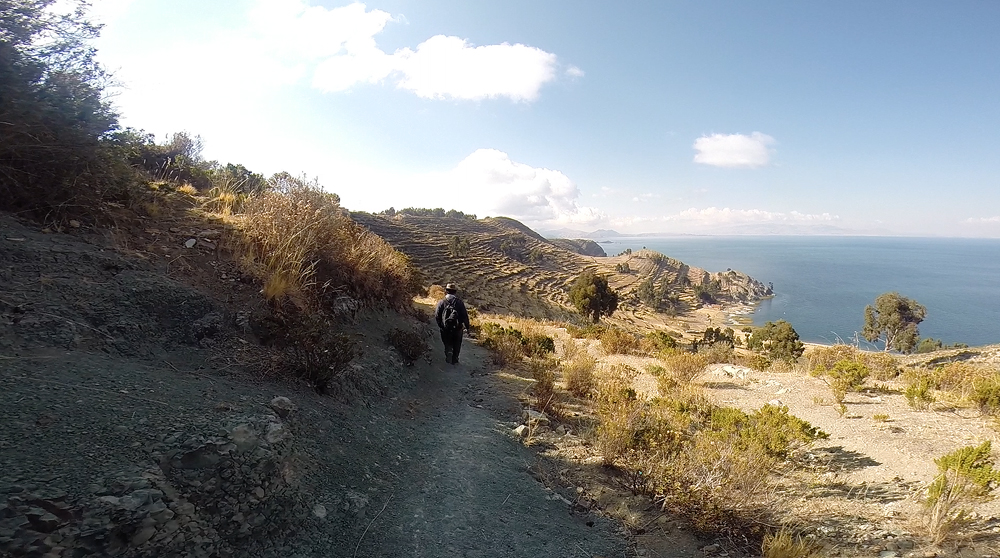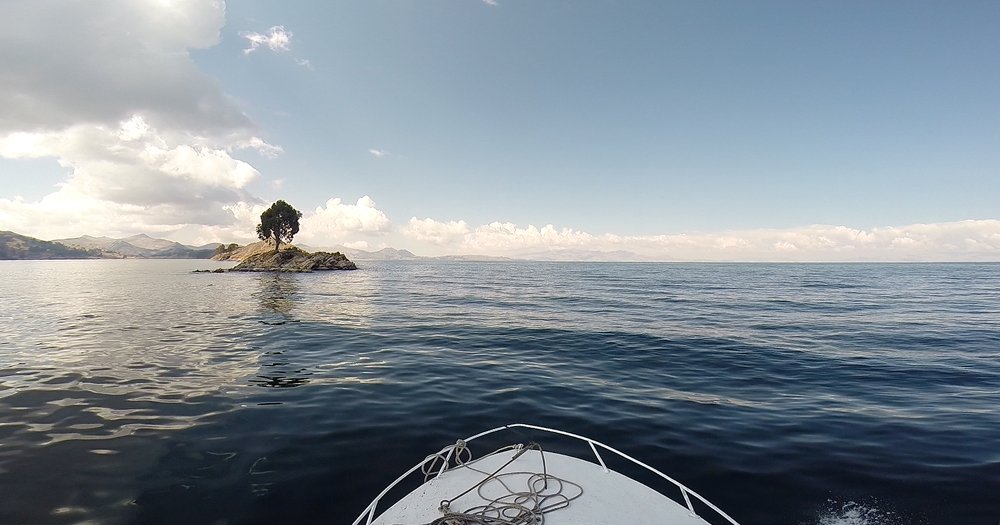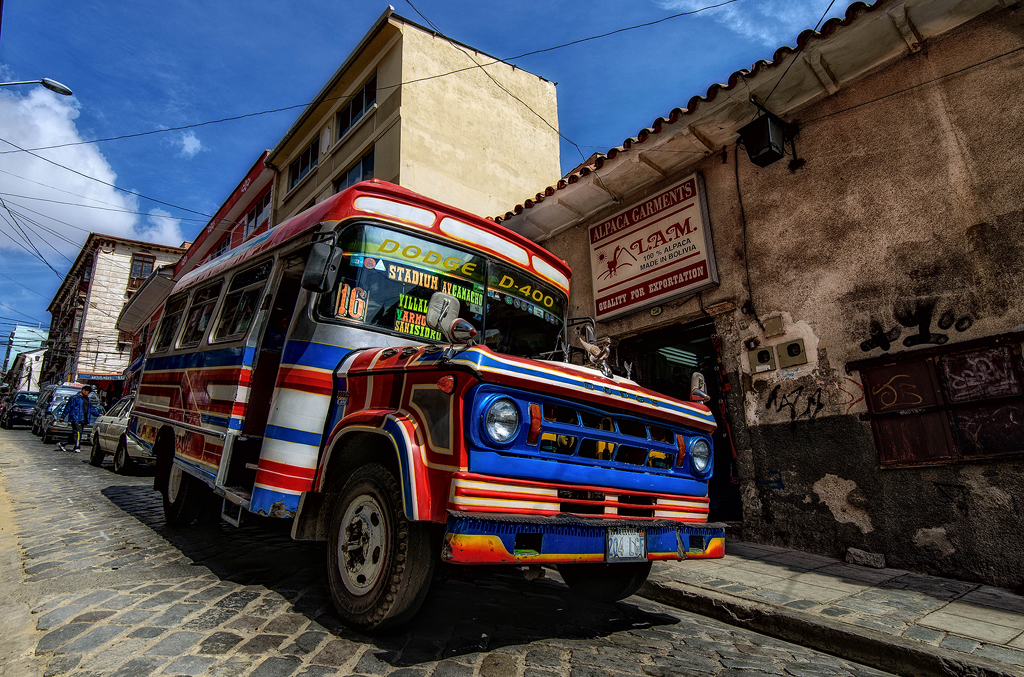ALTIPLANO PART 4: LAKE TITICACA AND LA PAZ
Flying into La Paz must be one of the most dramatic introductions to a city anywhere! On the short flight from Sucre we looked out of the window at large dusty plain of the Altiplano below us and slowly the outskirts of El Alto, the La Paz suburb which has become a city in it's own right, began to appear. Then the massive peak of Illumani, the highest mountain in Bolivia, the top of which seemed to reach to the same altitude as our plane, loomed into view. Then, below us, the streets and buildings of El Alto seemed to disappear over the edge of a cliff beneath the peaks of the mountains and a valley which resembled a crater or a bowl appeared. Lining the sides of the crater and tumbling all the way to the bottom is the city of La Paz, or Cidade da Nuestra Señora La Paz (City of Our Lady of Peace) to give it it's full name.
It's an astonishing location for a city. The centre sits in the lowest part of the bowl at around 3200m above sea level, but over the years, as the city grew it spread up the side walls of the valley, creating districts which seem to cling precariously to the edges, until eventually the city spilled over the top of the crater onto the Altiplano, creating the suburb of El Alto at an altitude of 4000 meters. It's here in El Alto that the airport is located, and the final pass over the city as we came into land really was breath-taking. We climbed straight into a taxi and headed to our hotel in downtown La Paz, right at the bottom of the valley. Once again the city left us speechless as the road from the airport heads straight to the edge of the cliff, and then as it reaches the edge it twists to the left and starts to snake down the edge of the crater wall. The whole city of La Paz lays spread out beneath the road and the views are amazing. As the road descends, it enters the different neighbourhoods until it reaches the valley floor of downtown La Paz. The traffic here was something else. I've seen congestion in cities like Bangkok and Mandalay, but here the valley walls surrounding the city trap the pollution in the city and the air feels pretty thick, which combined with the altitude made our heads spin a little.
We dropped our bags in the hotel and went out to explore the city. I was determined to get a shot of the whole city from the valley edge above the city, so in the late afternoon we asked a taxi driver to take us back the way we'd come out of the city to the edge El Alto, where I hoped to be able to get a photo of the whole of La Paz with the mountain of Illimani above and behind it. I found a spot and settled in with the camera and tripod, and then as the shadows lengthened, I photographed the different districts of the city and the cable cars which go from the edge of the cliff in El Alto down into the heart of La Paz. Unfortunately there were no clouds, but the light was lovely and I captured the image at the top of this post as the days last light caught the peak of Illumani.
We headed back down into the city as it got dark, got something to eat, then had an early night as we had to get up really early the following morning to catch the bus to Titicaca. We'd arranged with the hotel to leave our bags there as we would be coming back in a couple of days and just needed a small backpack each with a change of clothes and camera gear for the trip to Isla del Sol on the lake. We'd arranged the bus tickets to Copacabana (on the edge of Lake Titicaca) with the hotel, so the bus came to pick us up there at around 7am. However, despite it being a Sunday morning, traffic was incredibly heavy so moving through the city took forever and it was quite a while before we were climbing back up the road out of the city and entering El Alto. It's an amazing suburb, thriving with life and bustle, and somewhere I'd like to spend some time if we ever go back to that part of the world. Traffic was still incredibly thick though, at one point I counted 5 or 6 lines of traffic going in the same direction. Here are some screen grabs from video I shot with the GoPro while we were on the bus
Eventually we were out of the city and heading across the Altiplano to Lake Titicaca. The scenery here is very different to that which we'd seen during our time crossing the Altiplano to the south. Here it was greener and much more inhabited with farms and small villages. After a few hours Lake Titicaca came into view, and it really is massive. It's difficult to think of it as a lake as it's impossible to see the other side, it disappears over the horizon where Bolivia ends and Peru begins. The lake is so big that at one point we had to cross a part of if that cuts deep inland at San Pedro de Tiquini. It's an interesting process; we had to get off the bus leaving all our stuff onboard. The bus was then rolled onto a tiny wooden barge barely big enough to hold it which then slowly and precariously crossed the stretch of water. Meanwhile we crossed with the other passengers in small boats whilst watching the barges carrying the buses cross hoping they didn't sink. Finally, at the other side, we climbed back onto our bus and made the rest of the journey to Copacabana, the small dusty town that sits at the edge of the lake.
t's not the most attractive town, and we quickly arranged tickets on the next boat out to Isla del Sol. We had to wait a couple of hours before departure though, so we headed to a restaurant with a roof terrace and got some lunch. Pretty much every building in Copacabana is a hotel or a restaurant, so it's easy to find somewhere to eat. We then headed to the dock, climbed onto our boat, waited for it to fill up, then cast off and headed out onto the lake towards the island where we'd planned to spend a couple of nights. It takes about an hour and a half to get out there, and in that time we got a clear idea of the size of the lake. It was an amazing feeling being here, this lake at the roof of the world, the sky felt so close. We landed at the dock in Yumani and were met by a young girl who was going to take us to our accommodation. Isla del Sol has no roads or cars, so everyone gets around by walking or donkey. This is fine when you're at the top of the island, but to get there from the water's edge means climbing up paths for an ascent of about 200 meters. Lisbon, where we live, is a hilly city, and our house is in a neighbourhood at the top of one of those hills. I couldn't say for sure, but I'd guess it's about 200 meters above sea level and most days I'll walk from the river's edge up to our home without even slightly raising my pulse, but this 200 meter climb from the edge of the lake to the guesthouse at the top of the island had us gasping for air after just a few minutes. The difference that altitude makes to activity really is astonishing, and by this time we'd actually been acclimatising for well over a week. The top of the island is around 4000 meters, and by the time we reached it we felt as though we'd climbed ever one of those meters ourselves rather than just ascending the last 200 from the lake's edge.
We checked into the hotel and spent an hour or so sitting soaking up the sun drinking a welcome apple juice. Then, as the sun got lower, I picked up my camera gear and headed around from the western side of the island where our guest house was to the centre of the village of Yumani to try and find a spot to photograph the peaks of the Cordillera Real on the eastern side of the lake as the sun set. The plan was that the setting sun behind me would light up the snow on the peaks on the opposite horizon just before setting. I eventually found a spot with an unobstructed view in a small Llama field, and passed a peaceful hour surrounded by the animals watching the peaks change colour as the sun set. Sadly, there wasn't a single cloud in the sky but the afterglow light was pretty stunning.
Back at the hotel we ate a fantastic dinner before I headed out to try and do some star photographs. While the sky was clear and the view of the stars fantastic, I couldn't really find anything to compose against the sky (this part of the island has almost no trees) and there were a lot more lights from small villages on the edge of the lake than I expected. After about an hour of struggling in the cold, I gave up for the night and went to bed.
The following day we decided to hike the length of the island. It's not particularly big, and although it's hilly there's nothing like the climbs we'd done the day before to reach the village from the edge of the lake so it wasn't particularly challenging. The main danger is the strength of the sun so hats and sunscreen are essential. It was a pleasant walk along a well marked path, and when we reached the end of the trail, we simply turned around and walked back. The views throughout were lovely, and it's possibly the freshest air I've ever breathed - or maybe it just felt like that after our previous night in La Paz.
hen we got back to the hotel we had a rest and some tea, then as the shadows lengthened I headed out to photograph the sunset again. I took a few shots of the valley near our guesthouse before heading back to the same spot as the previous night. This time there were clouds around the peaks of Illampu and Ancohuma, and some wonderful light against the peaks as the sun set so I managed to get some nice images before heading back for dinner.
As it was the last night I'd have an opportunity to photograph the stars I'd been giving some thought to the best way of doing it and in the end I decided that as there was no foreground interest nearby to put in the shot against the stars, the best solution was to use myself and do it as a portrait. I found spot where I could get the camera below a ridge which cut out the lights on the edge of the lake shore and on which I could stand and reach out to "hold the stars" using 20 second timer on the camera. So with the camera set at a high ISO (4000) to pick up as much light as possible, and with the aperture wide open and the shutter at 30 seconds I went and stood in the scene with my arms out, waited for the click of the shutter opening, then counted the 20 seconds off trying my best not to move a muscle in the high wind and cold temperatures until I heard the second click of the shutter closing. I then went and checked the screen to make sure I'd stood in the right place (which I hadn't for the first 3 attempts) before repeating the process until I got it right. When I had a shot of me standing in the right place beneath the stars I took another two images of the sky directly above so I could stitch all the images together in a vertical panorama that would show around 120 degrees of the sky.
By the time I'd finished this I was thoroughly cold and ready for bed, so I headed back to the guest house's dining room and joined Teresa in warming myself against the wonderful fireplace before heading off to bed.
The night before the owner of the guest house had told us that a large group of people had rented a boat to pick them up in Copacabana and bring them to the island the following morning so there would be a boat leaving Japapi, the dock just below the guest house, earlier than the usual scheduled boat back to Copacabana from Yumani. This meant we'd get back to the mainland an hour earlier than we'd previously planned, giving us time to have lunch before catching the bus back to La Paz. It also saved us having to walk back to the eastern side of the island to the Yumani dock.
So the next day we got up early, had breakfast, and then headed off with the boatman. The path was right next to the guesthouse and the boatman set off at an amazing pace, scampering down the path, which was little more than a gully, with the speed and agility of a mountain goat. Fortunately, the altitude didn't really affect us as much going down as it had climbing up a couple of days previously and we were soon at the dock and getting on the boat. As it turned out we had the boat completely to ourselves for the crossing to Copacabana so we decided to go up on the roof. It felt as though we had our own private boat, and made for a lovely trip back.
Pretty soon we were back in Copacabana where we found a restaurant and settled in for lunch. We took it easy and were back at the bus stop in plenty of time for the trip back. Many of the people on our bus were making their way from Peru and so when we entered La Paz it was their first view of the city. There was an audible gasp as we turned onto the road that snaked down the edge of the cliff above the city and pretty much everyone crowded to one side of the bus to take in view.
After getting dropped off we grabbed a coffee, dropped off our bags at the hotel, then headed out for a last walk around the city. I wanted to get some portraits and street scenes, and Teresa wanted to buy some of the amazing blankets you find all over this part of world. I photographed some of the amazingly colorful buses you see in La Paz and a couple of the streets, but I was still determined to get a good portrait before I left.
While Teresa was haggling for blankets I hung around outside and this amazing face caught my eye. I recognized from his hat that he was from one of the tribal people who live in the area around Tarabuco near Sucre. I never find it easy to ask for portraits, but after about 5 minutes of telling myself that I'd regret it if I didn't, I finally approached him and asked if he was from Tarabuco. His face creased into a huge smile, and I asked if he'd mind me photographing him. He agreed on the condition that I bought one of his blankets, and so I quickly moved across the street so I could position him against a dark background and took three frames. He insisted on seeing the results, laughing out loud at his photograph, and then there was just the blanket transaction to carry out and we knew that our time in Bolivia was done. Walking back to the hotel I snapped a few images of local woman who were in some kind of demonstration, and then we got back to the hotel for our last meal, packing, and an early nigh
The next day we got a taxi to the airport and then a flight to Lima. We headed back across Titicaca again and this time I got an aerial view of the lake and Cordillera Real, as well as a stunning view of clouds pushing up against the edge of the Peruvian Andes before we descended into Lima. We changed there for a flight to Madrid, and from there it was a short hop back home to Lisbon, which was sunny and warm and most appealing, at sea level!
It had been an amazing trip, the extreme altitude, sun and temperatures, along with the constant overland travel had made it a challenging experience, and so we were already planning for the next trip, to Indonesia, to be a little less demanding.



